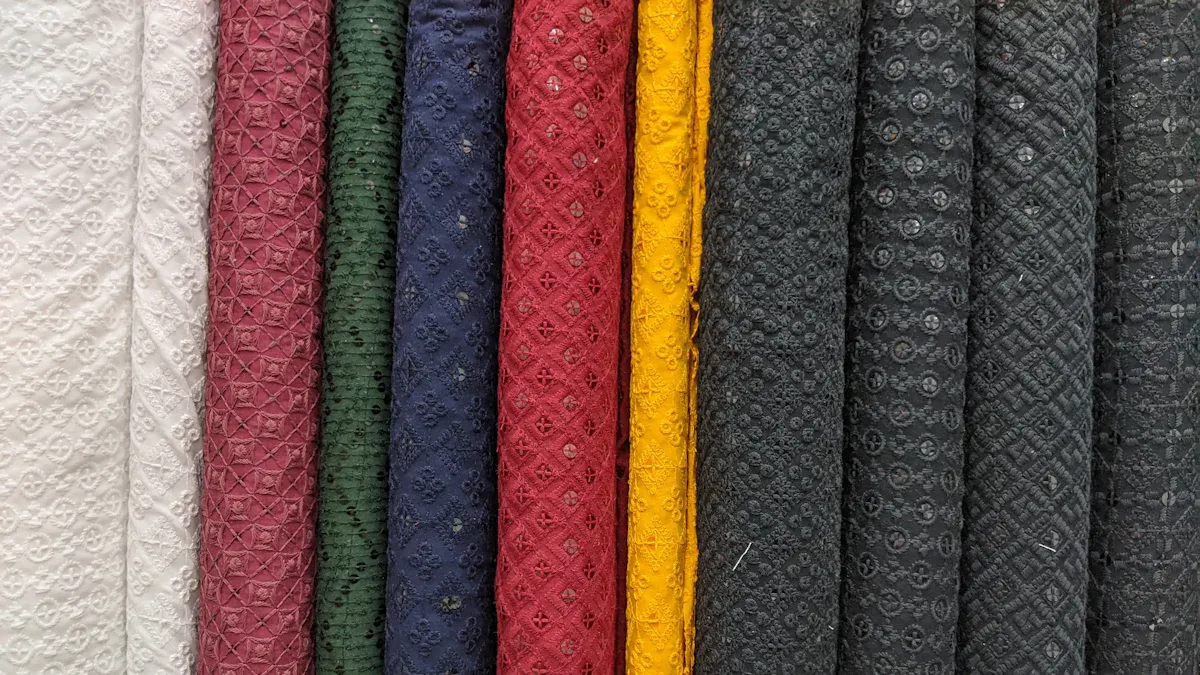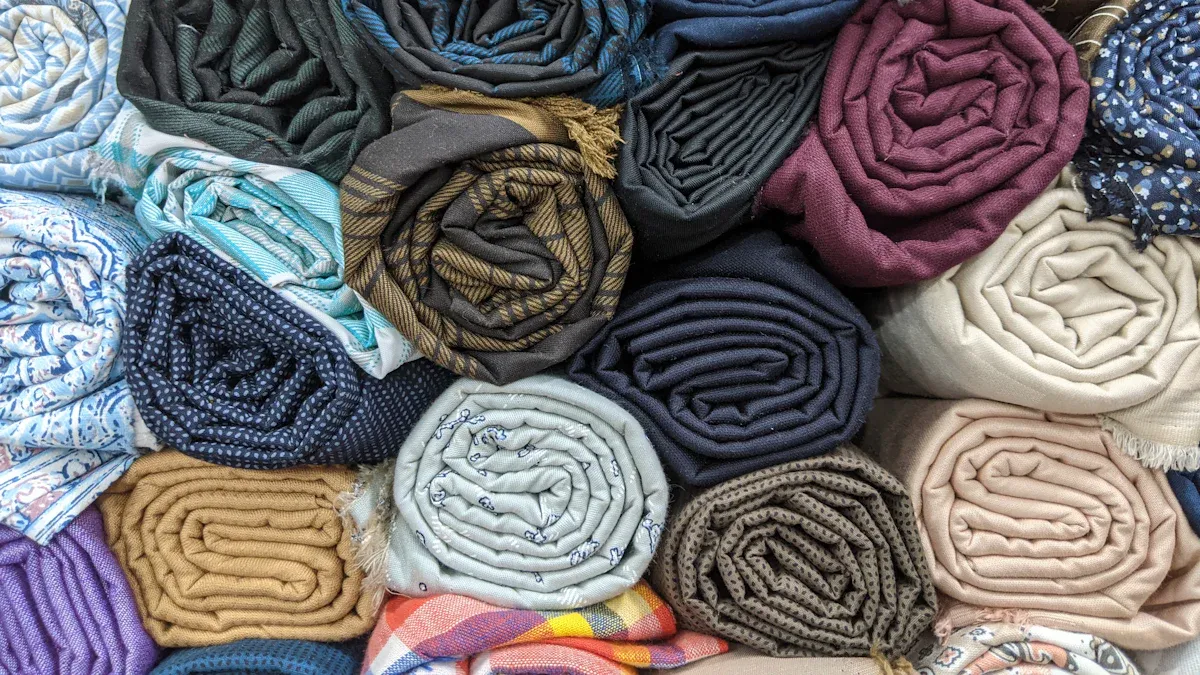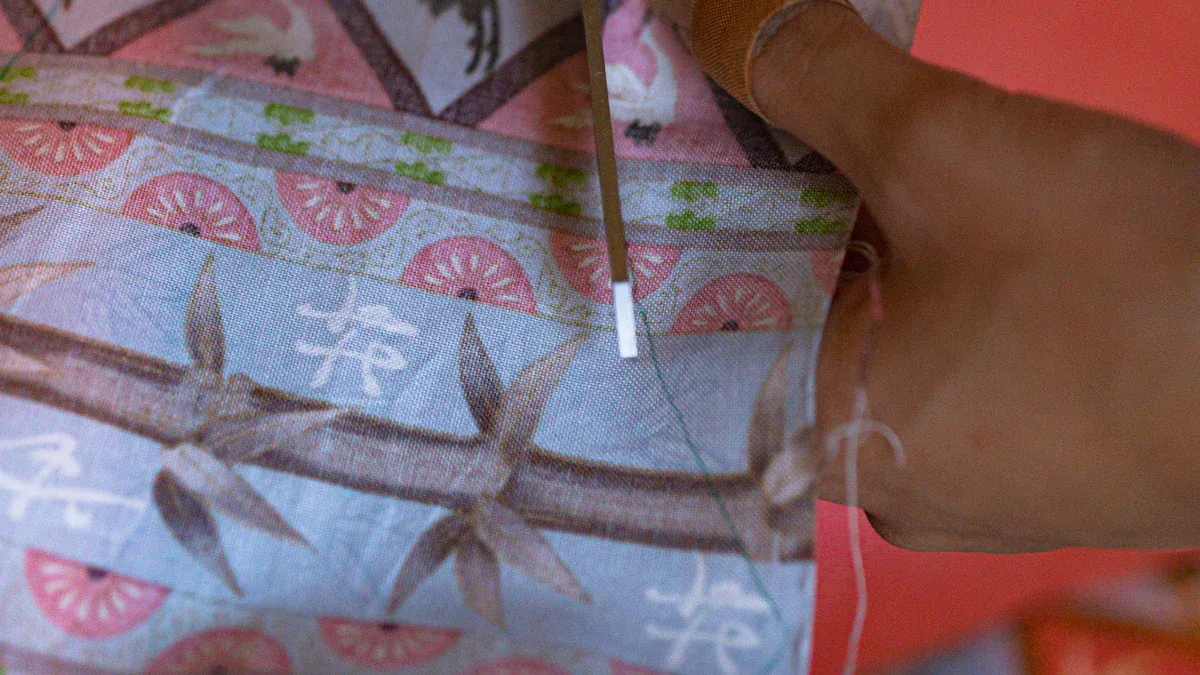
When you want your whole cloth quilt to feel soft, last for years, and look beautiful, cotton quilting fabric stands out as the best fabric for whole cloth quilts. The right fabric makes a huge difference in how your wholecloth quilt feels and holds up over time.
You’ll notice that things like weight, texture, and strength all play a part in comfort, durability, and the smooth look of your quilts. Fanda Fabrics offers premium options, giving you confidence when choosing fabrics for your next wholecloth project.
With a little know-how, finding the best fabric for whole cloth quilts becomes easy and fun.
Key Takeaways
Choose 100% cotton fabric for softness, durability, and easy sewing in whole cloth quilts.
Prewash your fabric to prevent shrinkage and color bleeding, ensuring a smooth, lasting quilt.
Pick fabric with a tight weave and good thread count for clear quilting stitches and long-lasting quality.
Match your fabric choice to your project type, like double gauze for baby quilts or sateen for decorative quilts.
Use quality tools and prepare your fabric well to make quilting easier and achieve professional results.
Best Fabric for Whole Cloth Quilts

Top Choices
When you start searching for the best fabric for whole cloth quilts, you want something that feels soft, looks beautiful, and stands up to years of use. Most quilters agree that 100% cotton is the top choice.
You’ll find that Fanda Fabrics’ Cotton Quilting Fabric and Solids Cotton Fabric check all the boxes for quality, comfort, and style. These fabrics come in a wide range of colors and textures, so you can match your creative vision with ease.
If you look at what other quilters use, you’ll notice a clear trend. According to recent quilting surveys, about 70% of quilters prefer solid fabrics or tone-on-tone options for their whole cloth quilt projects.
Cotton fabrics, especially those with a higher thread count, are the most popular. You get a fabric that’s easy to work with, feels great against your skin, and holds up well after many washes.
Here’s a quick comparison to help you see why these fabrics stand out:
Quality Aspect | Cotton Poplin Fabric (Solids) | Quilting Cotton Fabric |
|---|---|---|
Durability | Dense, tightly woven, highly durable | Strong weave, high thread count, durable |
Texture & Feel | Crisp, smooth, subtle ribbing, structured finish | Soft, smooth, flexible, classic cotton feel |
Ease of Sewing | Less stretch, easy to piece, crisp edges | Forgiving, good for curves and hand sewing |
Care & Maintenance | Shrinks less, holds color well, easy to wash | May shrink more, colorfast, easy care |
Drape | Structured, holds shape, less fluid | Softer, more flexible, drapes gently |
Best For | Modern, geometric, bold quilts | Traditional, curved designs, cozy quilts |
Tip: If you want a quilt with crisp lines and a modern look, go for cotton poplin. If you love a soft, cozy feel and plan to do hand quilting, choose classic quilting cotton.
Why Cotton Quilting Fabric?
You might wonder why cotton quilting fabric is the best fabric for whole cloth quilts. The answer is simple. Cotton gives you a soft, breathable, and durable base that feels comfortable year-round.
When you use Fanda Fabrics’ Cotton Quilting Fabric, you get a fabric that’s easy to cut, sew, and quilt. It holds its shape, resists fraying, and keeps its color wash after wash.
Solid cotton fabric from Fanda Fabrics also makes a great choice for wholecloth quilts. It offers a smooth, even surface that shows off your quilting stitches. The fabric’s tight weave means your quilt will last longer and look fresh, even after lots of use. You can pick from a huge range of colors, so your whole cloth quilt matches your style or home décor.
Quilters love these fabrics because they make the process simple and enjoyable. You don’t have to worry about tricky seams or complicated piecing. Just pick your favorite color or pattern, layer your quilt, and start stitching. With the right cotton fabric, your wholecloth quilt will turn out soft, sturdy, and beautiful—ready to be loved for years.
What Is a Wholecloth Quilt?
Wholecloth Quilt Defined
If you want a quilt that feels classic and simple, you might love a wholecloth quilt. In this style, you use one single piece of fabric for the front and another for the back. You don’t have to sew lots of small pieces together. Instead, you focus on the quilting stitches and the binding.
According to Penelope Handmade, a wholecloth quilt skips the patchwork and lets you show off your quilting skills. This makes it a great choice if you’re just starting out or if you want a project that comes together quickly.
When you make a whole cloth quilt, you get to highlight the beauty of the fabric and the texture of your stitches. The design stands out because there are no seams or busy patterns to distract from your work.
Many quilters find this process relaxing and rewarding. You can finish a wholecloth quilt faster than a traditional patchwork quilt, so it’s perfect if you want to see results soon.
Tip: If you’re searching for how to make a whole cloth quilt, start by picking a fabric you love. The fabric will be the star of your project!
Fabric Needs for Wholecloth Quilts
Choosing the right fabric is key when you make a quilt like this. For wholecloth quilts, you want a single, wide piece of fabric. Wide quilt backing fabric usually ranges from 108 to 120 inches. This size lets you cover the whole quilt top and back without seams.
You should pick a piece that’s at least 4 inches bigger on each side than your quilt top. This extra space helps when you quilt and prevents shifting.
Most quilters prefer high-quality, pre-shrunk, 100% cotton for wholecloth quilts. Cotton gives you a smooth, stable surface and feels soft against your skin. It also holds up well to washing and daily use.
When you use a single, seamless piece, your quilt looks clean and professional. You don’t have to worry about matching seams or patterns. Just focus on your quilting design and enjoy the process.
If you want to make a quilt that lasts, always choose the best fabric you can find. A whole cloth quilt made with premium cotton will stay beautiful for years.
Key Qualities of Wholecloth Quilt Fabric
Fiber Content
When you pick out fabric for your whole cloth quilt, fiber content matters a lot. Most quilters choose 100% cotton because it feels soft, breathes well, and lasts through years of use. Cotton fabrics are easy to sew and care for, which makes your wholecloth project much more enjoyable.
Some people like to experiment with linen or blends, but cotton remains the top choice for comfort and reliability. If you want a quilt that feels cozy and stands up to daily life, stick with natural fibers.
Weave & Thread Count
The weave and thread count of your fabric shape how your wholecloth quilt looks and feels. Plain weaves give you a smooth, matte surface that’s easy to quilt and shows off your stitching. Twill weaves add a bit of texture and a diagonal pattern, which can make your quilt look more interesting.
Satin weaves bring a shiny, elegant finish, perfect if you want a touch of luxury. For thread count, aim for fabrics in the 200-250 range. This sweet spot gives you both durability and softness. Higher thread counts can feel flimsy, while lower counts might not feel as smooth.
Softness & Comfort
You want your whole cloth quilt to feel soft and inviting. The softness comes from both the fiber and the weave. Cotton, especially with a higher thread count, feels gentle against your skin. Some quilters love using double gauze or flannel for extra softness and drape.
Linen starts out crisp but softens with each wash, making your quilt more comfortable over time. Washing your quilt also helps create that crinkly, cozy texture everyone loves.
Flannel and double gauze fabrics offer extra softness.
Linen softens after washing and adds breathability.
Mixing cotton with other soft fabrics can boost comfort.
Durability
Durability is key if you want your wholecloth quilt to last. Cotton fabrics with a tight weave and the right thread count resist wear and tear. They hold up well to repeated washing and daily use.
Twill and plain weaves both offer good strength, so your quilt stays beautiful for years. Always check that your fabric feels sturdy but not stiff. When you choose high-quality materials, your whole cloth quilt becomes a lasting treasure.
Comparing Wholecloth Quilt Fabrics
When you start a wholecloth quilt, the fabric you pick shapes the look and feel of your project. Let’s break down the most popular options so you can choose what works best for you.
Quilting Cotton
Quilting cotton is the classic choice for wholecloth quilts. You get a soft, smooth surface that shows off your stitching. Fanda Fabrics’ Quilting Collection gives you a huge range of colors and patterns.
This fabric holds up well to washing and daily use. It’s easy to sew, so you can try detailed kantha stitching or simple lines. If you want a quilt that feels cozy and lasts for years, quilting cotton is a safe bet.
Tip: Quilting cotton works great for both modern and traditional wholecloth quilts. It’s also perfect for kantha projects because it handles hand stitching well.
Muslin
Muslin gives you a natural, simple look. It’s usually less expensive than other fabrics. Many quilters use muslin for practice or for a classic, understated wholecloth quilt.
The fabric feels soft and gets even softer with each wash. Muslin is a favorite for kantha quilts, especially if you want a vintage vibe. Just remember, muslin can be a bit sheer, so you may want to use a thicker batting.
Flannel
Flannel brings extra warmth and softness. If you want a snuggly wholecloth quilt for winter, flannel is a great pick. It’s gentle on the skin and perfect for baby quilts. Flannel also works well for kantha stitching, giving your quilt a plush, textured feel. Keep in mind, flannel can stretch, so handle it gently when you sew.
Sateen & Specialty
Sateen has a smooth, shiny finish. It adds a touch of luxury to your wholecloth quilt. You might choose sateen for a decorative throw or a special kantha piece. Specialty fabrics, like organic cotton or linen, offer unique textures and eco-friendly options. Fanda Fabrics’ Solid Color Cotton Fabric lets you explore these choices with confidence.
Here’s a quick table to help you decide:
Fabric Type | Best For | Kantha Suitability | Feel/Texture |
|---|---|---|---|
Quilting Cotton | Everyday, heirloom, modern | Excellent | Soft, smooth |
Muslin | Vintage, practice, classic | Great | Soft, natural |
Flannel | Baby, winter, cozy | Good | Plush, warm |
Sateen/Specialty | Decorative, luxury, eco-friendly | Good | Silky, unique |
Note: For kantha quilts, all these fabrics work, but quilting cotton and muslin are the most popular. Choose what feels right for your project.
Preparing Fabric for Wholecloth Quilts

Getting your fabric ready is a big part of preparing a wholecloth quilt. If you want your quilt to look crisp, last longer, and show off your quilting stitches, you’ll want to follow a few simple steps before you start marking a quilt or sewing.
Prewashing
Prewashing your fabric can save you a lot of trouble later. Here’s why you should always wash your fabric before starting a wholecloth project:
Prewashing stops shrinkage that can make your finished quilt look puckered or uneven.
It helps prevent dye bleeding, especially with bold colors like red or purple.
Washing removes chemicals and sizing, making the fabric softer and safer for your skin.
You’ll notice that prewashing can remove the stiffness that helps with cutting, so you might want to add starch back in later.
Skip prewashing for precut fabrics, since they can fray or lose their shape.
Tip: Always test a small piece first if you’re worried about color bleeding. This step helps you avoid surprises after you finish your wholecloth quilt.
Pressing & Starching
Pressing and starching make a huge difference when you’re marking a quilt or cutting fabric. Starched fabric feels firmer and acts more like paper, so you get cleaner cuts and less stretching. Here’s what you gain:
More stability, which helps when marking lines or using marking devices.
Crisp, sharp cuts for better accuracy.
Less fraying, so your fabric stays neat.
Seams press flat and stay put, making your quilt blocks look professional.
Apply starch in light layers and press after each spray. This keeps your fabric smooth and ready for marking a quilt with your favorite marking tools.
Colorfastness
You don’t want your beautiful wholecloth quilt to bleed color after its first wash. Test for colorfastness by soaking a small piece in warm water or pressing a damp white cloth onto it.
If you see dye transfer, wash the fabric again or use color catchers. Even after testing, wash your finished quilt in cold water with gentle detergent and color catchers to keep colors bright.
Note: Careful fabric prep means your marking methods and marking devices will work better, and your wholecloth quilt will look amazing for years.
Choosing Fabric by Project Type
Baby Wholecloth Quilts
When you make baby quilts, safety and comfort come first. Babies have sensitive skin, so you want to pick fabrics that feel soft and gentle. Double gauze fabric is a top choice for baby wholecloth quilts. It feels light, airy, and super soft—perfect for snuggling. You’ll want to prewash double gauze, iron it carefully, and use a new needle to avoid snags.
Try a longer stitch length and lighter thread for the best results. Pairing double gauze with wool batting, especially merino wool, creates a quilt that keeps babies warm in winter and cool in summer. Merino wool absorbs moisture and feels gentle, making it a safe pick for your first quilt project or a thoughtful gift.
Double gauze: soft, delicate, and breathable
Merino wool batting: regulates temperature, hypoallergenic, and extra cozy
Tip: If you’re choosing fabrics for a beginner project, double gauze and merino wool make the process easy and the quilt extra special.
Lap & Throw Quilts
Lap quilts and throw quilts get a lot of use, so you want something durable and comfortable. Dress weight pure cotton is a favorite for these types of quilts. It’s easy to sew, feels great, and holds up to daily life. Always prewash your fabric to stop shrinkage later.
If you want a little shine, try sateen. Its glossy finish makes kantha stitching pop. For the batting, natural fibers like cotton or wool work well, but some quilters like low loft polyester for softness and easy hand quilting. Make sure your backing fabric matches the quality of your top layer for a quilt that lasts.
Fabric Type | Best For | Why Choose It |
|---|---|---|
Lap quilt, throw | Soft, durable, easy to sew | |
Sateen | Kantha, throws | Glossy, highlights stitching |
Cotton Batting | Lap, throw | Soft, easy to quilt |
Polyester Batting | Lap, throw | Soft, easy hand stitching |
Note: Lap quilts are perfect for cozying up on the couch or gifting to friends. They’re also a great way to practice kantha techniques.
Decorative Quilts
Decorative quilts let you show off your creativity. You can use specialty fabrics like sateen, linen, or even organic cotton for a unique look. These fabrics highlight your kantha stitches and make your quilt stand out.
Decorative quilts often hang on walls or drape over furniture, so you can focus on texture and color. Try mixing solid cottons from Fanda Fabrics with bold patterns for a modern twist. Decorative quilts are a fun way to explore different types of quilts and experiment with new kantha designs.
If you love kantha, decorative quilts give you the freedom to try new stitches and patterns. Choosing fabrics with interesting textures makes your work shine.
Where to Buy Wholecloth Quilt Fabric
Fanda Fabrics
If you want a trusted place to buy fabric for your wholecloth quilt, Fanda Fabrics makes a great choice. You get access to a huge variety of fabrics, including patchwork quilt fabrics in different lengths, widths, and thicknesses.
You can pick from five unique fabric selections, so it’s easy to find the right color, pattern, or texture for your project. Fanda Fabrics even offers pre-cut fabric squares and bundles, which help you start your quilt faster.
You might love the chance to personalize your quilt. Fanda Fabrics lets you customize your order, whether you want a special color or a unique design. Their professional design team supports your creative ideas, and you can count on fast delivery.
Many quilters, from beginners to experts, praise the softness and durability of these materials. You can feel confident knowing you’re getting high quality fabric that will last.
Tip: If you want a simple, elegant, or modern look, check out their Two Fabric Quilt Patterns. These designs make your quilt stand out without extra effort.
Online & Local Options
You have lots of ways to shop for wholecloth quilt fabric. Online stores give you access to a wide range of choices, while local shops let you feel the fabric before you buy. No matter where you shop, keep these tips in mind:
Check the thread count. Look for around 60 threads per square inch for a good balance of softness and strength.
Feel the fabric. It should be smooth and soft, not stiff or rough.
Watch for fraying. Good fabric won’t fray much at the edges.
Fold the fabric and run your nail along the crease. A lasting crease means the fabric holds its shape.
Make sure the fabric is 100% cotton, especially if you want quilting cotton.
Ask for swatches if you shop online. This helps you check color and texture before you buy.
Read reviews and check store policies. A good reputation means you’re more likely to get what you expect.
Note: Always review care labels and test for colorfastness. This helps your quilt stay bright and beautiful after washing.
Wholecloth Quilt Fabric Checklist
Ready to start your wholecloth quilt? A good checklist keeps you organized and helps you avoid surprises. Here’s what you’ll want to have on hand before you begin:
🧵 Fabric & Prep
Quilt Top Fabric: Choose high-quality cotton, like Fanda Fabrics’ Cotton Quilting Fabric or Solids Cotton Fabric. Pick a piece that’s at least 4–6 inches larger on each side than your planned quilt size. This extra space makes quilting and trimming much easier.
Backing Fabric: Select a backing that matches or complements your top. Make sure it’s also oversized for easy layering.
Batting: Pick the right thickness for your project—cotton, wool, or polyester all work well.
Sample Swatches: Test your thread colors and quilting patterns on small fabric samples. This step lets you see how everything looks before you commit.
Tip: Experienced quilters always make a small sample first. You can check thread color, weight, and quilting design. This helps you avoid surprises and get the look you want.
✂️ Essential Tools
Large, self-healing cutting mat for safe, accurate cuts.
Quilting ruler (24″ x 6.5″ or similar) for straight lines.
Basting spray or pins to hold layers together.
Seam ripper for quick fixes.
Small scissors or snippers for trimming threads.
Iron and ironing board for pressing fabric and seams.
1/4 inch seam foot for your sewing machine to keep seams even.
You might also like quilting gloves for better grip, binding clips instead of pins, a wool ironing mat for crisp seams, and a tailor’s clapper to set them flat.
Note: Having the right tools and prepping your fabric makes the whole process smoother. You’ll spend less time fixing mistakes and more time enjoying your quilting!
Conclusion
When you pick fabric for your wholecloth quilt, you want the best. Top choices include tightly woven cotton, cotton sateen for a touch of sheen, cozy flannel, and even linen for texture. Look for these key qualities:
Firm, tight weave for crisp quilting stitches
Softness and breathability
Durability for years of use
Prewashed to prevent shrinkage
Choosing high-quality fabric, like those from Fanda Fabrics, makes your quilt look and feel amazing. Match your fabric to your project’s purpose, and you’ll love the results. Creating a beautiful wholecloth quilt with the right fabric feels truly rewarding!
FAQ
What is the best fabric for a beginner’s wholecloth quilt?
If you’re just starting out, go with 100% cotton quilting fabric. It’s easy to sew, soft, and forgiving. Fanda Fabrics’ Cotton Quilting Fabric makes your first quilt project simple and enjoyable.
Do I need to prewash my fabric before quilting?
Yes, you should always prewash your fabric. This step helps prevent shrinkage and color bleeding later. You’ll get a smoother, more professional finish on your wholecloth quilt.
How much extra fabric should I buy for a wholecloth quilt?
Buy at least 4–6 inches more on each side than your planned quilt size. This extra fabric gives you room for quilting, trimming, and any shifting during the process.
Can I use patterned fabric for a wholecloth quilt?
Absolutely! Patterned fabrics add visual interest. Just remember, your quilting stitches may show up best on solid or lightly patterned fabrics. Fanda Fabrics offers both options.
Where can I find high-quality wholecloth quilt fabric?
You can shop online at Fanda Fabrics. They offer a wide range of premium cotton fabrics, solid colors, and custom options. You’ll find everything you need for your next quilt project.
